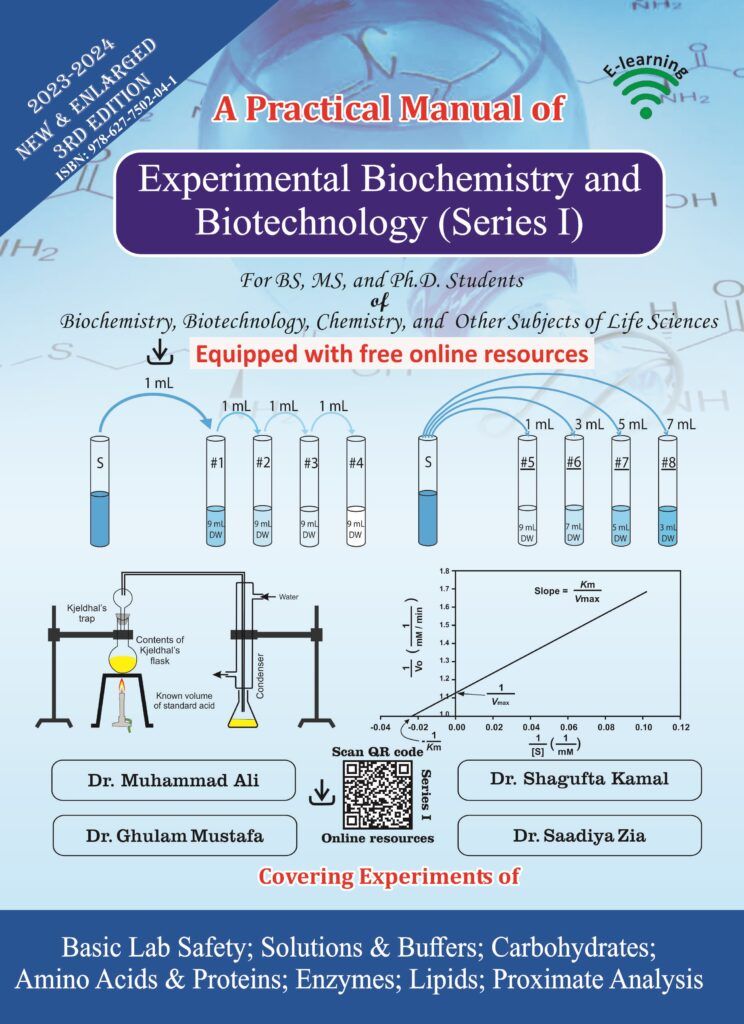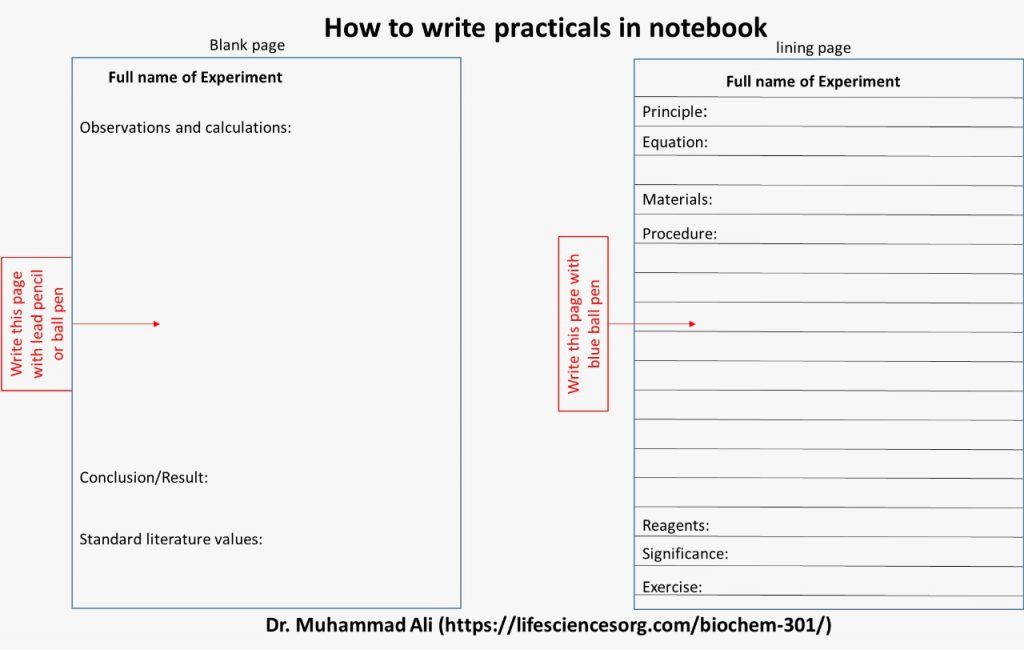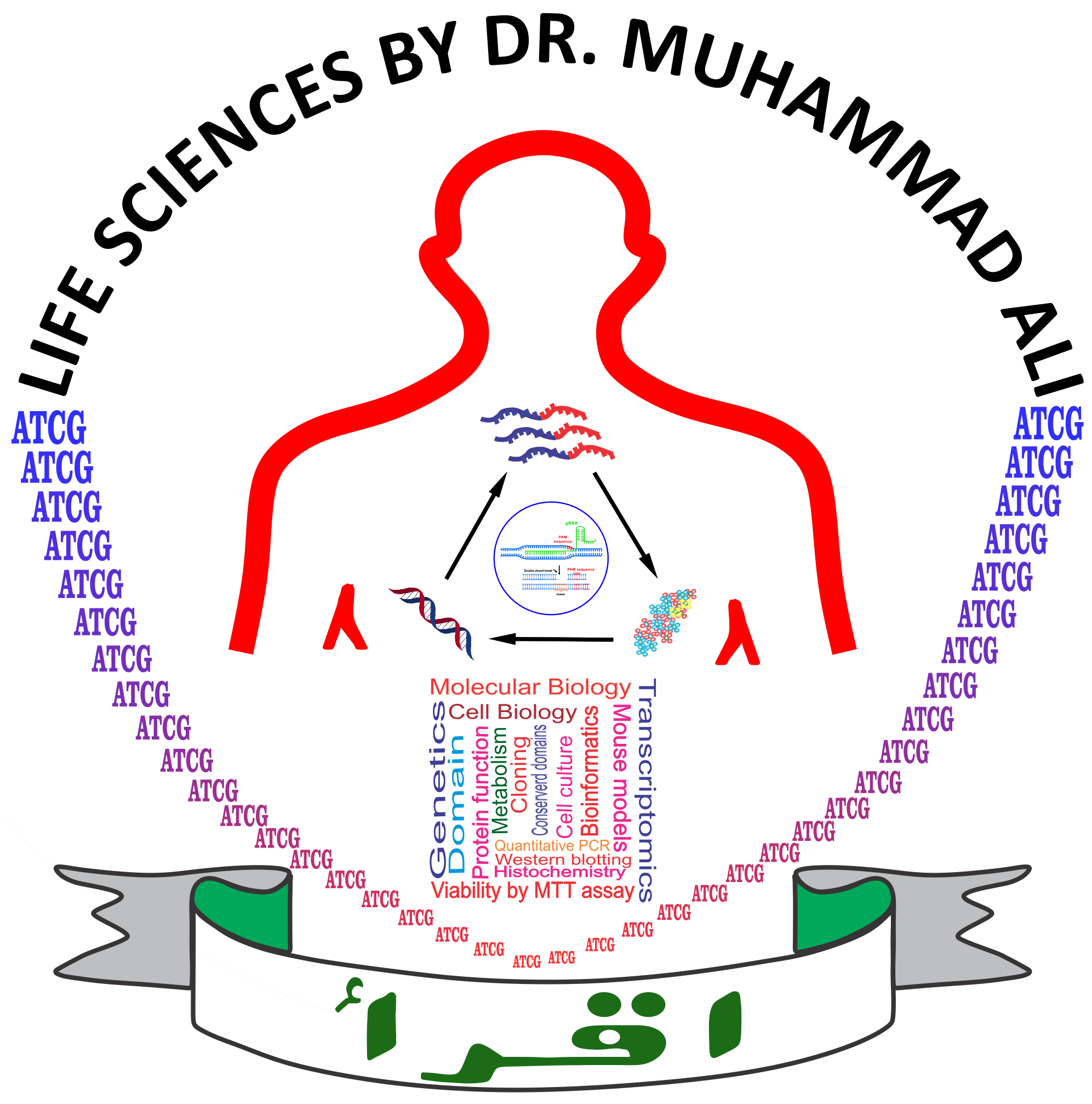Biochem-514, Biochemical Techniques, 3(1-2)
(list of practical)
- Study principles of spectrophotometry/colorimetry by preparing absorption spectra of any given sample; (4.10)
- Prove Beer’s law by creating standard graph between absorbance and concentration; (4.13)
- Demonstration about diffusion, dialysis and osmosis; (2.25, 2.26)
- Chromatography: Paper chromatography, one dimensional two dimensional, circular and column chromatography; (4.4, 4.8)
- Carbohydrate analysis and estimation of glucose by spectrophotometer; (3.9)
- Total protein estimation by Biuret/Bradford and UV method; (4.10, 4.11, 4.14)
- Cholesterol/sterol estimation by LB reagent method; (6.13)
- Proximate analysis of foods and feed; (7.1 to 7.11)
- Glycogen: Isolation and characterization; (3.16, 3.17)
- Electrophoresis of proteins/nucleic acids. (4.16)
Mid-term syllabus of Biochem-514, 3(1-2):
Good lab practices. Laboratory safety: Hazards in biochemistry laboratory, general safety measures, chemical, physical and biological hazards, spillage and waste disposal, radiation safety and first aid. General laboratory procedures; Laboratory glassware and basic instrumentation;
…. PLUS…. First 150 MCQs from chapters 2 of the book ” MCQs in Biochemistry”. MCQs from the taught concepts and book chapters will also appear in the exam.
Final syllabus of Biochem-514:
…. PLUS…. 30% of final paper will contain syllabus of mid
…. PLUS…. Standard procedures: Preparation and storage of reagents. Donnan’s equilibrium; Theoretical background of chromatography; Basics of electrophoresis; Importance of biochemical analysis in plant and animal sciences.
…. PLUS…. First 150 MCQs of each of chapter 2,3 of the book ” MCQs in Biochemistry”. MCQs from the taught concepts and book chapters may also appear in the exam.
Assignemtns and presentations of Biochem-514:
- The weightage of the assignment and presentation will be decided later.
- Start preparing your presentations and assignments….. Assignment submission is 18-04-2023.
- The presentations will also be started right after the mid-term exam.
- PPT file should not contain any designing/colours other than figures and diagrams.
- Slides should be in 16X9 ratio.
- Fonts of all header should be same and of all other text should be same.
- For detailed guidelines about the presentation of research article, visit: https://www.lifesciencesorg.combiochem-720/
- Download the template ppt file to make your presentation. The link is here (copy this link and paste in a new tab).
- Strictly follow the ppt format and it is better if you write and paste your material in the same ppt file.
NO EXCUSE WILL BE ACCEPTED
K. General Question to be asked during presentation
1) Pathway or importance of gene/technology/discovery
2) Rationale
3) Conclusion of the full article
4) Conclusion of every figure
5) New findings presented in the article
6) Applications of the findings
7) Future prospective
8) Applications of the work
9) Principle of every technique used in the research article
Moreover, provide me a printed summary of your article containing the above headings given under ‘K’.
L. During Presentations, for EVERY FIGURE and graph, we may ask:
1. The Principle of the experiment.
2. The Reason for doing the experiment.
3. The Physiological importance of the figure.
4. The Conclusions of the figure
5. Prepare well objectively and subjectively
__________________________________________________________________________________
Link to download the book ( MCQs in Biochemistry) is given below:
https://b-ok.cc/dl/1055171/2292c5
__________________________________________________________________________________
Meeting ID: 316 824 288 013
Passcode: WNyjeA
Microsoft teams will be used whenever online classes will be held. You must make your first name as your registration number.
2017-ag-9382 Haidar Iftikhar
2017-ag-10077 Ahmad Faraz
L. During Presentations, for EVERY FIGURE and graph, we may ask:
1. The Principle of the experiment.
2. The Reason for doing the experiment.
3. The Physiological importance of the figure.
4. The Conclusions of the figure
5. Prepare well objectively and subjectively
- BIOCHEM-514 Biochemical Techniques 3(1-2)
Course Learning Outcomes
By the end of this course students will be able to;
- 1. Demonstrate lab. safety related knowledge and protocols, alongwith general lab tools and instruments
- 2. Relate advance knowledge of chromatography, dialysis, photometry, electrophoresis in the analysis of biomolecules
- 3. Estimate and identify biomolecules via chromatography, colorimeter/spectrophotometer, titrations etc.
- 4. Analyse food and feed samples and learn electrophoresis
Theory
Good lab practices. Laboratory safety: Hazards in biochemistry laboratory, general safety measures, chemical, physical and biological hazards, spillage and waste disposal, radiation safety and first aid. General laboratory procedures; Laboratory glassware and basic instrumentation; Standard procedures: Preparation and storage of reagents. Donnan’s equilibrium; Theoretical background of chromatography; Basics of electrophoresis; Importance of biochemical analysis in plant and animal sciences.
Practical
Study principles of spectrophotometry/colorimetry by preparing absorption spectra of any given sample; Prove Beer’s law by creating standard graph between absorbance and concentration; Demonstration about diffusion, dialysis and osmosis; Chromatography: Paper chromatography, one dimensional two dimensional, circular and column chromatography; Carbohydrate analysis and estimation of glucose by spectrophotometer; True protein estimation by Biuret/Bradford and UV method; Cholesterol/sterol estimation by LB reagent method; Proximate analysis of foods and feed; Glycogen: Isolation and characterization; Electrophoresis of proteins/nucleic acids.
Suggested Readings
- 1. Boyer, R.F. 2014. Modern Experimental Biochemistry. 3rd Ed. The Benjamin/Cummings Publishing Co., USA.
- 2. Kaushik, G.G., N. Sharma, S. Dabeer and R. Jindal. 2020. Practical Manual of Biochemistry. CBS Publishers & Distributors Pvt Ltd, India.
- 3. Sawhney, S.K. and R. Singh. 2014. Introductory Practical Biochemistry. Narosa Publishing House, New Delhi, India.
- 4. Shawn, O.F. and L.E. Taylor. 2009. Biochemistry Lab Manual. Cengage Learning, USA.
- 5. Varley, H., A.H. Gowenlock, J.R. McMurray and D.M. McLauchlan. 2006. Varley’s Practical Clinical Biochemistry. 6th Ed. CBS Publishers and distributors. New Delhi, India.
- Wilson, K. and J. Walker. 2018. Practical Biochemistry: Principles and Techniques. 8th Ed. Cambridge University Press, UK.
- Ali, M. et al., Experimental Biochemistry and Biotechnology (Series I), 2023, 3rd edition, ISBN: 978-969-7502-04-1.
- Ali, M. et al., Experimental Biochemistry and Biotechnology (Series II), 2023. 2nd edition, ISBN: 978-969-7502-05-8.
- Ali, M. et al., Experimental Biochemistry and Biotechnology (Series III), 2024, 1st edition, ISBN: 978-969-7502-06-5.
| Biochem-514, BS Biochem, 6MB-Spring 2023, Dr. Muhammad Ali (30-01-2023 onwards) | |||||
| Sr. | Ag No. | Student’s Name | Group # | Topic | |
| 1 | 2020-ag-8541 | Amna Zafar | G1 | Integrated Proteogenomic Characterization of Clear Cell Renal Cell Carcinoma | 1st week after mid |
| 2 | 2020-ag-8544 | Areesha Naeem | |||
| 3 | 2020-ag-8545 | Arooj Rizwan | |||
| 4 | 2020-ag-8577 | Mahnoor Rauf | |||
| 5 | 2020-ag-8584 | Minahil Noor | |||
| 6 | 2020-ag-8587 | Momina Fatima | G2 | Endocytosis Inhibition in Humans to Improve Responses to ADCC-Mediating Antibodies | 1st week after mid |
| 7 | 2020-ag-8588 | Muhammad Adnan | |||
| 8 | 2020-ag-8589 | Muhammad Adnan Zahoor | |||
| 9 | 2020-ag-8590 | Muhammad Ahmad | |||
| 10 | 2020-ag-8591 | Muhammad Anwaar Mazhar | |||
| 11 | 2020-ag-8592 | Muhammad Babar Taimoor | G3 | Lipid-Associated Macrophages Control Metabolic Homeostasis in a Trem2-Dependent Manner | 1st week after mid |
| 12 | 2020-ag-8593 | Muhammad Hamza Javed | |||
| 13 | 2020-ag-8594 | Muhammad Mudassar Anwar | |||
| 14 | 2020-ag-8595 | Muhammad Rizwan Arshad | |||
| 15 | 2020-ag-8596 | Muhammad Shahzad | |||
| 16 | 2020-ag-8598 | Muhammad Usman Ali | G4 | Coordinate β-adrenergic inhibition of mitochondrial activity and angiogenesis arrest tumor growth | 2nd week after mid |
| 17 | 2020-ag-8599 | Muhammad Zain Sajjad | |||
| 18 | 2020-ag-8600 | Muizz Shahid | |||
| 19 | 2020-ag-8601 | Muqadas Fatima | |||
| 20 | 2020-ag-8602 | Namra Shahzadi | |||
| 21 | 2020-ag-8603 | Nawal Manzoor | G5 | Protein mimetic amyloid inhibitor potently abrogates cancer-associated mutant p53 aggregation and restores tumor suppressor function | 2nd week after mid |
| 22 | 2020-ag-8604 | Noor Ul Eman | |||
| 23 | 2020-ag-8606 | Qurat ul Ain | |||
| 24 | 2020-ag-8608 | Rimsha Fatima | |||
| 25 | 2020-ag-8609 | Rimsha Kanwal | |||
| 26 | 2020-ag-8610 | Sadia Habib | G6 | Rhoifolin from Plumula Nelumbinis exhibits anti cancer efects in pancreatic cancer viaAKT/JNK signaling pathways | 2nd week after mid |
| 27 | 2020-ag-8611 | Sahr Muneer | |||
| 28 | 2020-ag-8612 | Saif Ul Rahman | |||
| 29 | 2020-ag-8613 | Saman Liaqat | |||
| 30 | 2020-ag-8614 | Saman Saeed | |||
| 31 | 2020-ag-8615 | Sana Sarfraz | G7 | Cell-penetrating Alphabody protein scaffolds for intracellular drug targeting | 3rd week after mid |
| 32 | 2020-ag-8617 | Sara Nadeem | |||
| 33 | 2020-ag-8618 | Shumaim Mukhtar | |||
| 34 | 2020-ag-8619 | Sidra Sagar | |||
| 35 | 2020-ag-8620 | Soulat Fatima | |||
| 36 | 2020-ag-8621 | Syeda Sania Zahid | G8 | SREBP-1c impairs ULK1 sulfhydration-mediated autophagic flux to promote hepatic steatosis in high-fat-diet-fed mice | 3rd week after mid |
| 37 | 2020-ag-8622 | Syeda Sunober Saqlain | |||
| 38 | 2020-ag-8624 | Tunziha Shabbir | |||
| 39 | 2020-ag-8626 | Ume Rubab | |||
| 40 | 2020-ag-8627 | Zainab Noor | G9 | Insulin- and Lipopolysaccharide-Mediated Signaling in Adipose Tissue Macrophages Regulates Postprandial Glycemia through Akt-mTOR Activation | 3rd week after mid |
| 41 | 2020-ag-8628 | Zeeshan Azam | |||
| 42 | 2020-ag-8629 | Tuba Majeed | |||
| 43 | 2020-ag-8631 | Muhammad Usman | |||
| 44 | 2020-ag-9763 | Abdullah | |||
| Biochem-514, BS Biochem, 6EA-Spring 2023, Dr. Muhammad Ali | |||||
| Sr. | Ag No. | Student’s Name | Group # | Topic | Date |
| 1 | 2020-ag-8632 | Aaima-Tur-Rehman | G1 | Integrated Proteogenomic Characterization of Clear Cell Renal Cell Carcinoma | 1st week after mid |
| 2 | 2020-ag-8633 | Aleeha Khurram | |||
| 3 | 2020-ag-8634 | Amna Abbas | |||
| 4 | 2020-ag-8635 | Amna Batool | |||
| 5 | 2020-ag-8636 | Aneeq Munsif | |||
| 6 | 2020-ag-8637 | Aniqa Alwi | |||
| 7 | 2020-ag-8638 | Areej Fatima Khan | G2 | Endocytosis Inhibition in Humans to Improve Responses to ADCC-Mediating Antibodies | 1st week after mid |
| 8 | 2020-ag-8639 | Arham Ali | |||
| 9 | 2020-ag-8640 | Ayesha Rasheed | |||
| 10 | 2020-ag-8641 | Ayesha Zia | |||
| 11 | 2020-ag-8642 | Bisma Yousaf | |||
| 12 | 2020-ag-8643 | Esha Anwar | |||
| 13 | 2020-ag-8644 | Esha Sarwar | G3 | Lipid-Associated Macrophages Control Metabolic Homeostasis in a Trem2-Dependent Manner | 1st week after mid |
| 14 | 2020-ag-8645 | Faiza Jabeen | |||
| 15 | 2020-ag-8646 | Hadia Tahir | |||
| 16 | 2020-ag-8647 | Hamna Chaudhary | |||
| 17 | 2020-ag-8648 | Hurara Ashraf | |||
| 18 | 2020-ag-8649 | Ifra Asghar | |||
| 19 | 2020-ag-8650 | Ifra Asim | G4 | Coordinate β-adrenergic inhibition of mitochondrial activity and angiogenesis arrest tumor growth | 2nd week after mid |
| 20 | 2020-ag-8652 | Iqra Shahid | |||
| 21 | 2020-ag-8653 | Khadija Zahra | |||
| 22 | 2020-ag-8654 | Kinza Sameen | |||
| 23 | 2020-ag-8655 | Laiba Abrar | |||
| 24 | 2020-ag-8656 | Laiba Kiran | |||
| 25 | 2020-ag-8657 | Linta Mustafa | G5 | Protein mimetic amyloid inhibitor potently abrogates cancer-associated mutant p53 aggregation and restores tumor suppressor function | 2nd week after mid |
| 26 | 2020-ag-8658 | Mahnoor Muqadas | |||
| 27 | 2020-ag-8659 | Maleeha Tariq | |||
| 28 | 2020-ag-8660 | Moattar Fatima | |||
| 29 | 2020-ag-8661 | Moazim Rehman | |||
| 30 | 2020-ag-8662 | Muhammad Awais | |||
| 31 | 2020-ag-8663 | Muhammad Faizan | G6 | Rhoifolin from Plumula Nelumbinis exhibits anti cancer efects in pancreatic cancer viaAKT/JNK signaling pathways | 2nd week after mid |
| 32 | 2020-ag-8664 | Muhammad Kashif | |||
| 33 | 2020-ag-8665 | Muhammad Muneeb Qamar | |||
| 34 | 2020-ag-8666 | Muhammad Umar | |||
| 35 | 2020-ag-8667 | Muneeba Naveed | |||
| 36 | 2020-ag-8668 | Muntaha Fatima | |||
| 37 | 2020-ag-8670 | Narmeen Zahra | G7 | Cell-penetrating Alphabody protein scaffolds for intracellular drug targeting | 3rd week after mid |
| 38 | 2020-ag-8671 | Nashra Nadeem | |||
| 39 | 2020-ag-8672 | Nimra Ahmad | |||
| 40 | 2020-ag-8673 | Nirma Sarfraz | |||
| 41 | 2020-ag-8674 | Noor-ul-Huda | |||
| 42 | 2020-ag-8675 | Noshaba Naz | |||
| 43 | 2020-ag-8676 | Rida Zainab | G8 | SREBP-1c impairs ULK1 sulfhydration-mediated autophagic flux to promote hepatic steatosis in high-fat-diet-fed mice | 3rd week after mid |
| 44 | 2020-ag-8678 | Romaan Abeer | |||
| 45 | 2020-ag-8679 | Sadaf Manzoor | |||
| 46 | 2020-ag-8680 | Sadia Falak | |||
| 47 | 2020-ag-8681 | Samra Murtaza | |||
| 48 | 2020-ag-8682 | Shireen Faisal | |||
| 49 | 2020-ag-8683 | Sufyan Arif | G9 | Insulin- and Lipopolysaccharide-Mediated Signaling in Adipose Tissue Macrophages Regulates Postprandial Glycemia through Akt-mTOR Activation | 3rd week after mid |
| 50 | 2020-ag-8684 | Tania Javed | |||
| 51 | 2020-ag-8685 | Tehreem Ali | |||
| 52 | 2020-ag-8687 | Uqba Sarfraz | |||
| 53 | 2020-ag-8688 | Usama Bin Imran | |||
| 54 | 2020-ag-8689 | Zara Asmat | |||
| 55 | 2020-ag-8690 | Shaloom Suhail | |||




Comments are closed.